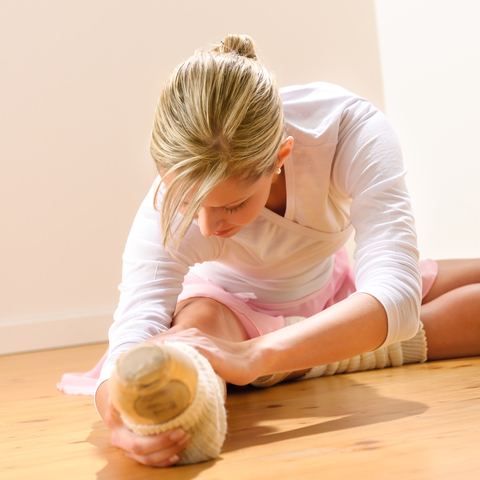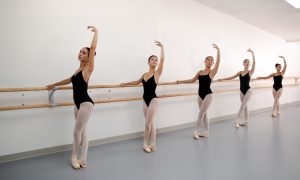By Rain Francis.
Do you stretch extensively before class? Do you often sit in a stretch for a few minutes or more? Do you stretch every single day?
As dancers, most of us would probably answer “yes” to at least one of the above questions – which would mean that we might have been practicing unsafely, and could be doing our bodies more harm than good. It’s time to get wise about the correct, safe and effective way to stretch.
Flexibility is important for injury prevention, physical fitness and mental and physical relaxation. Since all bodies are different, there is little point in comparing your flexibility to another dancers; flexibility is determined by genetics. However, stretching, when practiced correctly, can increase your flexibility and improve your performance.
When to Stretch
The most crucial factor in regards to stretching is to always warm up first. As much as we may be used to it, this means not sitting in stretches before barre! A proper warm-up should start with some light aerobic activity (such as a gentle jog around the studio) to increase your core temperature. When you produce a light sweat, it’s time to engage in some dynamic stretches. Dynamic stretching should start slowly and gradually increase in the speed and power of the movement. (See below for an explanation on the different types of stretching). Many Pilates exercises incorporate dynamic stretching, so before class is a good time to do your Pilates routine.
At the end of your cool down after class – when the activity that requires you to be strong and stable has ceased – is a good time to do your static stretches. Believe it or not, stretching to your end-range before class actually reduces strength and stability, as well as increases your risk of injury, so it should be avoided at all costs.
What to Stretch
It may feel good to practice the stretches that are comfortable for you, but it’s important to stretch the muscles that need to be stretched, not just the ones that are already flexible. Stretch both sides of a joint, in order to not develop an imbalance that could lead to injury. Practice stretches that only target the muscles you are trying to lengthen. Isolating a muscle group gives you greater control and means you are able to vary the intensity of the stretch.
How to Increase Flexibility
In order to maintain your range of motion, a weekly stretch session is sufficient. However, if your goal is to increase your flexibility, you need to stretch three to five times per week, and you need to be consistent. It may take several months for certain stretches to become comfortable, but perseverance is key (just make sure you are not pushing yourself to the point of pain.)
As it takes time for your muscles to adapt and adjust, you must give them time to heal, rest and repair themselves. This means mixing up your stretching program by alternating light days, heavy days and rest days. Any gym bunny knows the importance of working and resting different muscle groups on different days, and making gains in flexibility follows the same principles.
Though it may be tempting, over-stretching increases the risk of injury and can just push your goals even further away.
Stretches should be slow and gentle, and should never create a sharp or painful feeling. Use your breath to assist you, and do not bounce!
How Long to Hold Stretches
Hold your static stretch (but not your breath) for 30 seconds, then relax. After a brief rest, repeat the stretch two or three times. The changes in your flexibility from stretching in this way will only last less than an hour. However, when performed consistently, as explained above, flexibility gains can be maintained. If you are a child or young adult whose bones are still growing keep stretches to 10 seconds or less.
Contrary to what you may believe, prolonged stretching should only be used by medical professionals and is not appropriate for dancers. Rather than simply stretching muscles and their connective tissues, stretching for extended periods of time can elongate joints and ligaments, which are there to keep your joints stable. You may think that lying in second while watching TV is doing you good, but this can actually lead to loss of stability and serious injury, whether in the short-term or further down the track.
The Importance of Breath
There is a reason why yoga and Pilates place so much emphasis on the incorporation of the breath. Correct breath control is essential to getting the most out of your flexibility training. It helps relax the body, improve muscular elasticity, increase blood flow and remove lactic acid, which reduces muscle soreness and the risk of injury.
When stretching during your cool-down, keep your breath fluid, not forced. Use slow, relaxed breathing, with an emphasis on exhalation through the mouth or nose. Inhale through the nose, which will filter and warm the air you inhale and allow more oxygen into your lungs (just ask any yogi!)
Types of Stretching
There are several different techniques for stretching muscles, each with advantages and disadvantages. You should consult an experienced teacher or health care professional to find the best technique for your physique.
There are two main types of stretching: static and dynamic.
Static stretching is a stretch that is held in a particular position. For example, lying on your back with one leg raised in the air and gently easing the leg in toward the chest to stretch the hamstrings. Static stretching is more effective than dynamic stretching for producing long-term flexibility, but should only be practiced when the body is fully prepared.
Dynamic stretching is a stretch that is an active movement as a result of muscle contraction. For example, circling the ankle or shoulders, or controlled leg and arm swings. This type of stretching takes you to the limits of your range of motion, with no bouncing or jerking. A good dynamic stretch is one that reproduces the movement patterns required for the exercise you are about to undertake. For dance, an example is a controlled développé to the front or side, which dynamically stretches the hamstrings. Dynamic stretching should be performed only after a proper warm-up.
When researching for this article the author consulted the following resources:
Stretching – a vital part of dancers training and practice, by Tania Huddart for DANZ ©. www.danz.org.nz/Magazines/DQ/April2012/stretching.php
Stretching for dancers, by Brenda Critchfield, MS, ATC, under the auspices of the Education and Media Committees of the International Association for Dance Medicine and Science. www.iadms.org/displaycommon.cfm?an=1&subarticlenbr=353
Stretching rules for dancers, by Ausdance. www.ausdance.org.au/articles/details/stretching-rules-for-dancers
Photo: © Candybox Images | Dreamstime.com















